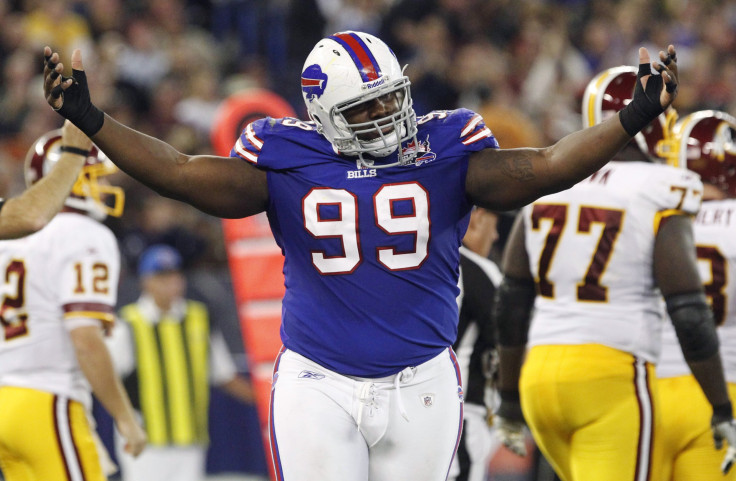Buffalo Bills 2015: Free Agency, Draft Options Should Address LB And RB Issues

The Buffalo Bills are coming off their first winning season in 10 years and nearly made the postseason for the first time since 1999 thanks to one of the best defenses in the NFL. Ranking fourth in total defense and third against the pass, the Bills went 9-7 despite the glaring absence of a franchise quarterback and an offense that was No. 26 overall.
Given how Buffalo utilized its salary cap, it makes sense that the defense nearly snapped its 15-year playoff drought. Last year, $38.25 million was devoted to the offense, and $65.9 million to the defense -- one of the biggest discrepancies in the NFL.
Still, the Bills have $29.6 million in salary cap space, the eighth highest total in the NFL this offseason, and most of that can be used to keep players already on the roster this year and in 2016.
The Bills are in such an excellent financial position largely because a huge chunk of their cap isn’t devoted to $20 million-per-year quarterback.
Thus, how Bills general manager Doug Whaley and newly tabbed head coach Rex Ryan build up the offense, specifically around young and cheaply paid quarterback E.J. Manuel will be the key factor in the team’s possible ascendance in the AFC East and the conference next season.
While finding a replacement for Doug Marrone, Whaley reportedly desired a coach who could help Manuel develop after a solid rookie year. In 10 games, the 24-year-old completed 58.8 percent of his attempts for 1,972 yards and 11 touchdowns to nine interceptions before his rookie year was cut short by a knee injury and the Bills exercised caution.
In 2014, Marrone pulled Manuel after four games in favor of Kyle Orton, and while the offense played better under Orton, he never figured to be the long-term solution Buffalo needs under center.
Even if Ryan and his staff can only marginally improve Manuel’s play next season, the former Florida State standout’s development is critical to Whaley keeping the team’s cap under control. Assuming the postseason is within reach next season, the Bills can neither afford to select and build up another quarterback, nor can they throw more money at another veteran that could go to the defense or an offensive skill position.
If the Bills do decide to pursue a quarterback, it would almost certainly have to be through free agency. Recent news that the Bills met with Josh McCown generated little enthusiasm. Jake Locker, who at age 26 still has room to grow, might be the only reasonable option. But Locker has had injury problems in the past, and might command a contract too lucrative for the Bills.
Manuel will register a $2.4 million and $2.8 million cap hit the next two seasons, allowing Whaley the flexibility necessary to keep stacking the defense.
When the new league year begins March 10 and free agents hit the open market the Bills will have several topline players to address. The list includes: running back C.J. Spiller, inside linebacker Brandon Spikes, defensive end Jerry Hughes, free safety Da’Norris Searcy, defensive tackle Corbin Bryant and defensive end Jarius Wynn.
And next year’s potential free agent class could be even more important. In 2016 defensive tackle Marcell Dareus, cornerback Stephen Gilmore, linebacker Nigel Bradham, and running backs Fred Jackson and Bryce Brown will all be up for new contracts.
Of 2015’s bunch, Hughes will undoubtedly be Buffalo’s top priority. Last season, Hughes was third on the team with 9.5 sacks, and along with Dareus and defensive end Mario Williams, formed the heart of the league’s top ranked pass rush. Hughes also led the team with three forced fumbles, recovering one for a touchdown.
Now entering his sixth pro season, Hughes will likely seek a big increase over his total compensation of $3.9 million last season. The top 10 highest-paid defensive ends in the league, a group that also includes Williams, make a minimum of $9 million in 2015, a threshold the 26-year-old Hughes will probably cross with the Bills or a number of teams looking to immediately improve their pass rush.
Wynn and Bryant serve as Williams and Dareus’ back-ups on the depth chart, and considering they amounted to a cap hit of $1.13 million combined in 2014, Whaley is likely to keep both at a discount rate for insurance.
However, how long those deals run will play a huge role when Dareus is an free agent in 2016. Side-by-side with Williams, the 25-year-old Dareus was second on the team with 10.0 sacks last season, and he’s racked up 28.5 total sacks since he entered the league as the No. 3 overall pick in the 2011 draft.
Besides possessing the kind of pass rushing abilities rarely seen by someone his size and at his position, Dareus is also one of the most durable defensive tackles in the league. He’s missed one game, the season finale in 2014, throughout his young career.
Dareus represents an $8 million cap hit next season, and that figure will certainly rise when he’s an unrestricted free agent. Whaley is likely to structure Hughes’ deal so as to inflict minimal damage on 2016’s total cap hit and make ample room for Dareus. It serves to reason that Dareus could garner a deal like Baltimore’s Haloti Ngata at $16 million or Tampa Bay's Gerald McCoy at $14.5 million next season alone.
Searcy, who was fifth on the team in total tackles and came up with five passes defended after Jarius Byrd shuttled off to New Orleans, also figures to be a priority. But with key defensive backs like Corey Graham, Leodis McKelvin and Aaron Williams locked up until at least 2017, there’s a chance Buffalo lets the Searcy walk.
Spikes could also be shown the door. The Bills will welcome top linebacker and 2013’s top tackler and interception-leader Kiko Alonso back next season, assuming his torn ACL is healed. And 22-year-old rookie Preston Brown led the team in tackles last season and is scheduled to make only $702,000 in 2015.
Essentially the Bills defense is more than stacked, and has contingencies for many of its free agents this season, with Hughes and Dareus being the only exceptions the next two years.
In the draft, and on the cheap, is where Whaley likely retools the Bills offense.
Buffalo doesn’t own a first-round pick this year, trading it to Cleveland for the right to select electric receiver Sammy Watkins, but in the later rounds it can perhaps add some depth at running back and linebacker.
Spiller’s inconsistency and injury history, along with Jackson’s advanced age, 33, make both expendable the next two years, and running back a priority in the draft. But Buffalo can sit on that selection until the second or third rounds. While Wisconsin’s Melvin Gordon and Georgia’s Toddy Gurley are expected to be off the board by the late second round, Buffalo could start the next wave of rushers with Nebraska’s Ameer Abdullah, Boise State’s Jay Ajayi, or Miami’s Duke Johnson.
In the second round is where Buffalo could snag a linebacker. Virginia’s Eli Harold could slip, and Utah’s Nate Orchard and TCU’s Paul Dawson are both projected as second-round picks.
© Copyright IBTimes 2024. All rights reserved.





















